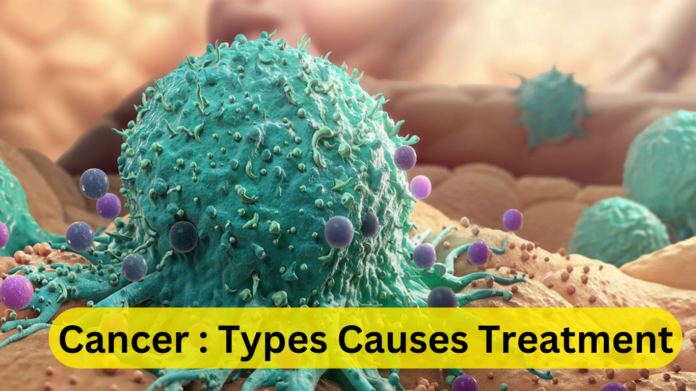Ad
The Definition of Cancer
Cancer is a disease in which some of the body’s cells grow uncontrollably and spread to other parts of the body.
Cancer can start almost anywhere in the human body, which is made up of trillions of cells. Normally, human cells grow and multiply (through a process called cell division) to form new cells as the body needs them. When cells grow old or become damaged, they die, and new cells take their place.
How it begins:
Cells are the basic units that make up the human body. Cells grow and divide to make new cells as the body needs them. Usually, cells die when they get too old or damaged. Then, new cells take their place.
It begins when genetic changes interfere with this orderly process. Cells start to grow uncontrollably. These cells may form a mass called a tumor. A tumour can be cancerous or benign. A cancerous tumour is malignant, meaning it can grow and spread to other parts of the body. A benign tumour means the tumour can grow but will not spread.
Types:
The four main types :
- Carcinomas. A carcinoma begins in the skin, or the tissue that covers the surface of internal organs and glands. Carcinomas usually form solid tumors. They are the most common type. Examples of carcinomas include prostate cancer, breast cancer, lung, colorectal cancer.
- Sarcomas. A sarcoma begins in the tissues that support and connect the body. A sarcoma can develop in fat, muscles, nerves, tendons, joints, blood vessels, lymph vessels, cartilage, or bone.
- Leukemias. Leukaemia is a cancer of the blood. Leukaemia begins when healthy blood cells change and grow uncontrollably. The four main types of leukaemia are acute lymphocytic leukaemia, chronic lymphocytic leukaemia, acute myeloid leukaemia, and chronic myeloid leukaemia.
- Lymphomas. Lymphoma is a cancer that begins in the lymphatic system. The lymphatic system is a network of vessels and glands that help fight infection. There are two main types of lymphomas: Hodgkin lymphoma and non-Hodgkin lymphoma.
How it spreads :
As a cancerous tumour grows, the bloodstream or lymphatic system may carry cancer cells to other parts of the body. During this process, the cells grow and may develop into new tumors. This is known as metastasis.
One of the first places it often spreads is to the lymph nodes. Lymph nodes are tiny, bean-shaped organs that help fight infection. They are located in clusters in different parts of the body, such as the neck, groyne area, and under the arms.
It may also spread through the bloodstream to distant parts of the body. These parts may include the bones, liver, lungs, or brain. Even if it spreads, it is still named for the area where it began. For example, if breast cancer spreads to the lungs, it is called metastatic breast cancer, not lung cancer.
Diagnosing cancer details :
Often, a diagnosis begins when a person visits a doctor about an unusual symptom. The doctor will talk with the person about his or her medical history and symptoms .
But many people with cancer have no symptoms. For these people, cancer is diagnosed during a medical test for another issue or condition.
Sometimes a doctor finds cancer after a screening test in an otherwise healthy person. to confirm or disprove the result of the screening test.
Treatment :
Cancer treatment is highly individualized and depends on various factors, including it type and stage , the patient’s overall health, and their preferences.
- Surgery: The removal of cancerous tumors or affected tissues.
- Radiation Therapy: The use of high-energy radiation to target and destroy its cells.
- Chemotherapy: The use of drugs to kill or inhibit cancer cells.
- Immunotherapy: The stimulation of the immune system to attack cancer cells.
- Targeted Therapy: The use of drugs that specifically target cancer cells.
- Hormone Therapy: Used for hormone-sensitive cancers.
- Stem Cell Transplantation: A procedure to replace damaged bone marrow with healthy stem cells.
- Precision Medicine: Targeting specific genetic mutations.
- Palliative Care: Focusing on symptom relief and emotional support.
- Clinical Trials: Access to experimental treatments that may not yet be widely available.
Treatment plans are tailored to individual patients, and often, a combination of these therapies is used.
Ad
Also read : H5N1 bird flu 100 times Worse Than Covid-19: Experts Raise Alarm
For education help visit : https://careerstudy.in
Ad





